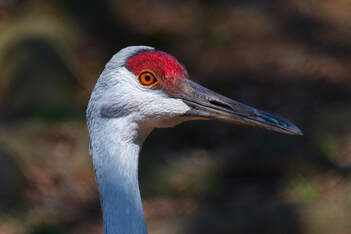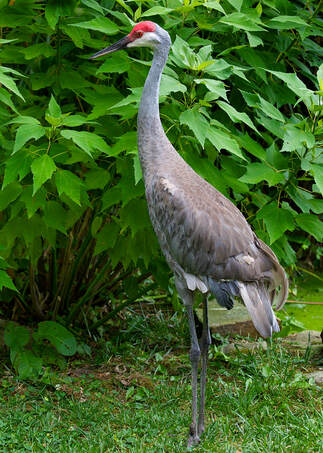Sandhill Crane (Grus canadensis)
|
Physical Description: Sandhill Cranes are large, tall birds with long necks and legs, and very broad wings. The bulky body tapers into a slender neck. Their heads are small, and their bills are straight and longer than their heads. On average, they have a 78-inch wingspan. They weigh between seven and ten pounds. The Sandhill Crane grows to 47 inches long on average.
They have gray feathers on their bodies and a red cap of feathers on their heads. Adults have pale-colored faces. They have black legs. Habitat: Sandhill Cranes breed and forage in open prairies, grasslands, and wetlands. Outside of the breeding season, they often roost in deeper water of ponds or lakes. Range: While they tend to winter in the southern United States and northern Mexico, they can be found throughout North America during the rest of the year. Diet: They are omnivores. They eat seeds, cultivated grains, berries, small vertebrates, and invertebrates such as insects, snails, reptiles, amphibians, nestling birds, and small mammals. Lifespan: The average life span is about 20 years in the wild. Social Structure: A pair mates for life and stays with their mate year-round. A clutch of eggs may contain up to three eggs but usually only one survives to fledge. After hatching the young stay with their parents for 9-10 months. Chicks can leave the nest and swim within eight hours of hatching. Status: Least Concern1 Other: Sandhill Cranes are elegant wetland birds. They tend to group together and may be seen in the hundreds and even thousands together in migrating flight and during winter nesting. The Sandhill Crane’s unique call is a loud, rolling, trumpeting sound. It is a product of anatomy. They have long windpipes that coil into the sternum. They are also known for their elaborate courtship dances. Courting cranes stretch their wings, pump their heads, bow, and leap into the air in a graceful and energetic dance. 1 https://www.iucnredlist.org/species/22692078/188597759 |
|








